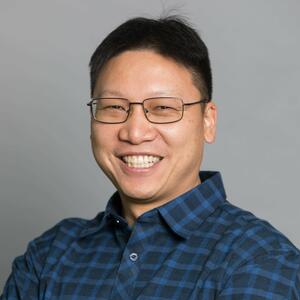Li-Fang (Jack) Chu, PhD
PhD, Cell and Molecular Biology, Baylor College of Medicine, USA
Areas of Research
Genetic Regulation of Developmental Clocks
In vitro segmentation clock model — a window to understand developmental timing: To identify the principles governing temporal developmental program, we are currently focused on the dynamic function of the segmentation clock, which controls somitogenesis with a species-specific periodicity. Recently, we established in vitro segmentation clock models using human ESC-derived PSM cells, displaying a human-specific gene oscillatory periodicity recapitulating segmentation clock in vivo. Equipped with these novel systems, we are now poised to make significant insights and ask key questions such as: What controls the tempo of a developmental clock? What are the extrinsic or intrinsic factors that could influence developmental timing? How do cells translate this temporal code into spatial identity information during development?
In vitro segmentation clock model — a window to understand developmental timing: To identify the principles governing temporal developmental program, we are currently focused on the dynamic function of the segmentation clock, which controls somitogenesis with a species-specific periodicity. Recently, we established in vitro segmentation clock models using human ESC-derived PSM cells, displaying a human-specific gene oscillatory periodicity recapitulating segmentation clock in vivo. Equipped with these novel systems, we are now poised to make significant insights and ask key questions such as: What controls the tempo of a developmental clock? What are the extrinsic or intrinsic factors that could influence developmental timing? How do cells translate this temporal code into spatial identity information during development?
Stem Cells and Regenerative Medicine
Modeling congenital spinal deformity in a dish — a model to search for novel therapeutic solutions: Defects in segmentation result in congenital vertebral anomalies, which are estimated to affect approximately 1 in 1000 live births. Those conditions include: 1) spondylocostal dysostosis (SCDO), a severe but rare condition with misshaped or fused vertebrae, and 2) congenital scoliosis (CS), a prevalent but less severe condition with lateral curvature of the spine. In both conditions, mutations have been identified primarily in the conserved NOTCH signaling pathway. However, due to the lack of proper human cell models, little is known about how these mutations or any additional environmental factors (e.g., temperature, hypoxia) disrupt the process of segmentation. To meet this need, we used genome editing to establish an in vitro model of SCDO4 in which human ESCs harbor the exact missense point mutation in exon 2 of HES7 (OMIM:608059), resulting in an Arg-to-Trp (R25W) substitution at an evolutionarily conserved residue in the DNA-binding domain (HES7R25W). We will use our models to: 1) serve as a cell-based platform for screening novel regulators to restore normal gene oscillation and 2) effectively build additional SCDO/CS models to investigate the influence of environmental factors on the penetrance of CS etiology.
Modeling congenital spinal deformity in a dish — a model to search for novel therapeutic solutions: Defects in segmentation result in congenital vertebral anomalies, which are estimated to affect approximately 1 in 1000 live births. Those conditions include: 1) spondylocostal dysostosis (SCDO), a severe but rare condition with misshaped or fused vertebrae, and 2) congenital scoliosis (CS), a prevalent but less severe condition with lateral curvature of the spine. In both conditions, mutations have been identified primarily in the conserved NOTCH signaling pathway. However, due to the lack of proper human cell models, little is known about how these mutations or any additional environmental factors (e.g., temperature, hypoxia) disrupt the process of segmentation. To meet this need, we used genome editing to establish an in vitro model of SCDO4 in which human ESCs harbor the exact missense point mutation in exon 2 of HES7 (OMIM:608059), resulting in an Arg-to-Trp (R25W) substitution at an evolutionarily conserved residue in the DNA-binding domain (HES7R25W). We will use our models to: 1) serve as a cell-based platform for screening novel regulators to restore normal gene oscillation and 2) effectively build additional SCDO/CS models to investigate the influence of environmental factors on the penetrance of CS etiology.
Biology of species-specific pluripotent stem cells
Species-specific cellular reprogramming — an opportunity to compare species-specific pluripotency and functional derivatives: We are interested in developing iPSCs from mammalian species with various gestation length for comparative developmental biology. Because the signaling requirement for maintaining the pluripotent state could be species-specific, standard mouse or human PSC protocols may not support other species directly. This presents both challenges and opportunities to explore the evolutionary conserved and unique features of pluripotency and cellular reprogramming.
Species-specific cellular reprogramming — an opportunity to compare species-specific pluripotency and functional derivatives: We are interested in developing iPSCs from mammalian species with various gestation length for comparative developmental biology. Because the signaling requirement for maintaining the pluripotent state could be species-specific, standard mouse or human PSC protocols may not support other species directly. This presents both challenges and opportunities to explore the evolutionary conserved and unique features of pluripotency and cellular reprogramming.
Supervising degrees
Veterinary Medical Sciences - Doctoral: Seeking Students
Veterinary Medical Sciences - Masters: Seeking Students
Biochemistry and Molecular Biology - Doctoral: Seeking Students
Biochemistry and Molecular Biology - Masters: Seeking Students
Biomedical Engineering - Doctoral: Seeking Students
Biomedical Engineering - Masters: Seeking Students
More information
Working with this supervisor
We are seeking highly self-motivated and creative candidates with a BSc or MSc degree and a background in genetics, developmental biology, biochemistry, and molecular biology to join our team. If you are fascinated by how stem cells decide their fates, how tissues and organs are formed, intrigued by the complexity of cell-cell communication, and want to help us build a dynamic, passionate, and interactive lab environment, we would love to have you here!
